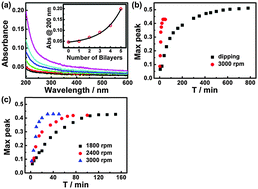Introducing a high gravity field to enhance infiltration of small molecules into polyelectrolyte multilayers†
Abstract
Loading functional small molecules into nano-thin films is fundamental to various research fields such as membrane separation, molecular imprinting, interfacial reaction, drug delivery etc. Currently, a general demand for enhancing the loading rate without affecting the film structures exists in most infiltration phenomena. To handle this issue, we have introduced a process intensification method of a high gravity technique, which is a versatile energy form of mechanical field well-established in industry, into the investigations on diffusion/infiltration at the molecular level. By taking a polyelectrolyte multilayer as a model thin film and a photo-reactive molecule, 4,4′-diazostilbene-2,2′-disulfonic acid disodium salt (DAS), as a model small functional molecule, we have demonstrated remarkably accelerated adsorption/infiltration of DAS into a poly(allylamine hydrochloride) (PAH)/poly(acrylic acid) (PAA) multilayer by as high as 20-fold; meanwhile, both the film property of the multilayer and photoresponsive-crosslinking function of DAS were not disturbed. Furthermore, the infiltration of DAS and the surface morphology of the multilayer could be tuned based on their high dependence on the intensity of the high gravity field regarding different rotating speeds. The mechanism of the accelerated adsorption/infiltration under the high gravity field was interpreted by the increased turbulence of the diffusing layer with the thinned laminar boundary layer and the stepwise delivery of the local concentration gradient from the solution to the interior of the multilayer. The introduction of mechanical field provides a simple and versatile strategy to address the paradox of the contradictory loading amount and loading rate, and thus to promote applications of various membrane processes.


 Please wait while we load your content...
Please wait while we load your content...